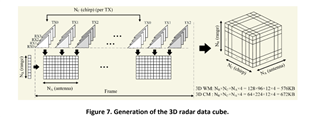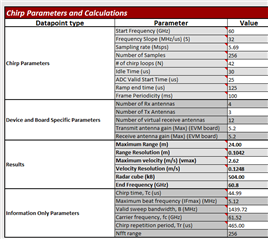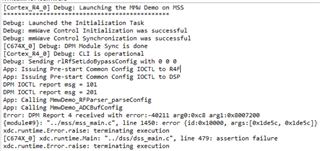Other Parts Discussed in Thread: IWR6843AOP, DCA1000EVM, MMWAVEICBOOST
Hi,
Our company wants to optimize the detection resolution (range, angular and elevation) based on a known maximum range and a minimum velocity resolution. We've had experience in the past with tuning the configuration, but we have an inquiry about the ADC sampling value with the 3D People Counting firmware v 4.7 - v 4.10.1
References:
Hardware -- IWR6843AOP EVM
[1] 3D_people_counting_detection_layer_tuning_guide.pdf (toolbox v 4.10.1)
[2] 3D_people_counting_tracker_layer_tuning_guide.pdf (toolbox v 4.10.1)
[3] Sensing Estimator (dev.ti.com/.../)
[4] Chirp Programming (www.ti.com/.../swra553a.pdf)
[5] 3D_people_counting_demo_implementation.pdf (toolbox v 4.10.1)
Question: With the firmware 3D People Counting v 4.7 - v 4.10.1, is it possible to have a numAdcSamples value higher than 128 (129+) ? If so, how can we achieve it ?
To respect the radar cube size of the default configuration set to 576KiB we tried to increase the number of ADC samples to 256 which would lead to a number of FFT bins of 256 as well. We there for reduces the number of chirp loops from 96 to 48 giving a radar cube size of (256 * 48 * 12 * 4) / 1024 = 576KiB. To accommodate the extra samples we increased the digoutsamplerate value from 2950 to 5900. Although this configuration should work the radar refuses to send values. we tried lowering the number of loops even further to 16 as well as increasing the sampling rate but the result is the same. Is there a hard limit on the number of ADC samples/ FFT bins in this version of the firmware, and if so how could we by pass it ?

Thank you for your kind support,
Justin




